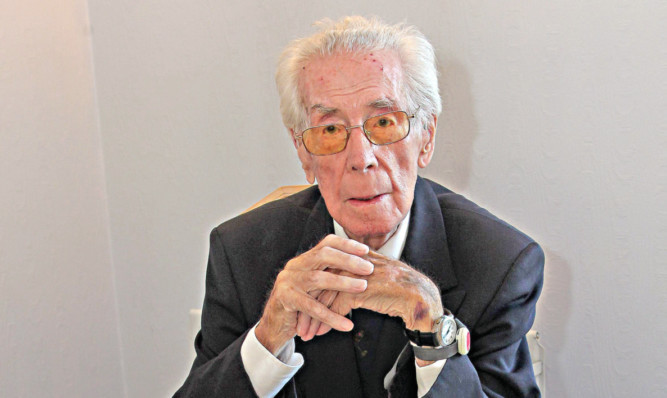
A blind former Spitfire pilot has revealed rare pictures from inside a German POW camp secretly taken using a tiny camera hidden inside a Bible.
Fife-born Andrew Morgan, 94, was held prisoner by the Nazis at the notorious Stalag IV B camp after his Spitfire was shot down just before Christmas 1943.
During his 18-month incarceration, he befriended a fellow prisoner who bribed German guards so they could smuggle parts into the camp, which they used to make a camera small enough to fit inside a hollowed-out Bible.
Now 70 years on Andrew has revealed for the first time the secretly-taken photos which give a fascinating insight into one of Germany’s biggest prisoner of war camps.
“They are unbelievable,” said Andrew’s daughter Issy, of Guildford, Surrey. “You never get pictures showing inside a German prisoner of war camp they are usually after they have been liberated.
“There are pictures of bedraggled Russians looking almost like Belsen concentration camp victims.
“There are photos of the British, who were treated much better and pictures of Germans during a roll call showing only their backs because they were taken secretly.
“There’s even a picture of the camera hidden in the Bible.”
Andrew who revealed last week how he attended a special party to celebrate the 100th anniversary of a charity that supports him helped build the camera.
But the images themselves were actually captured “for posterity’s sake” by a chum who later emigrated to Canada.
It was a risky hobby though as both men were under threat of being sent to solitary or even shot if they were caught.
After the war, Andrew’s pal posted the images to him, believing he would like to see them and he’s held on to them since.
It is now possible they could end up in a museum given their unique historical significance.
Last night, a spokesman for London’s Imperial War Museum said the images are “rare”, as there are only a few examples of photos taken in other POW camps.
“They give an amazing insight into life inside the camp,” agreed daughter Issy.
Andrew, a former professional footballer for Dundee FC, was a warrant officer with the City of Glasgow 602 squadron.
He flew more than 40 daring missions from 1941 but was shot down during an exercise over Nazi-occupied France.
“There was smoke coming out of the engine,” said Andrew, who lost his sight in 2001.
“I had to decide whether to parachute out or to crash land.”
The quick-thinking pilot decided to land the stricken Spitfire along an avenue of trees.
“I didn’t even have time to get out of the cockpit,” he said.
“There were German troops under the trees and they said, in English: ‘For you the war has finished.’
“I was taken into solitary confinement for three or four days.”
He was then moved to the camp north of Dresden deep inside Nazi Germany alongside some 30,000 other prisoners with more than 7,000 of them British.
Andrew remembers joining a British theatre group and playing football with fellow prisoners.
“One time we were playing in the yard and the football went under the fence and one of the prisoners reached under to get it.
“A German commandant shot him with a machine gun.
“He was only one of the young ones. It was a terrible situation.”
During his time in the camp at Muhlberg near the River Elbe, he recalled being put through a bizarre ordeal at the hands of Nazi doctors after being told he had diphtheria.
“I remember going for some tests, which I think were experiments,” he said.
“I have a strong memory of standing in the freezing cold snow without any clothes on.”
The camp was liberated by the Red Army in 1945 but Andrew was kept prisoner by the Russians until he was freed in a prisoner-swap for Russian Cossack soldiers who had fought for the Nazis.
After the war, he returned to play professional football as a striker for Fulham.
“When I came back, I couldn’t help gorging on food,” he said.
“And maybe a bit too much drink at times!”
Andrew spoke last week about how he was invited to Buckingham Palace to attend a garden party marking the centenary of the Blind Veterans UK charity, attended by the Countess of Wessex.
“It was so nice to be there with them,” he added.
Escape
A great escape at Stalag IV B was accidentally foiled by a German commandant having his portrait painted.
A British prisoner notorious for his audacious escape bids called Eddie “Shadow” Millard had burrowed secretly below the camp education hut.
He was in the secret burrow underneath a camp building when he heard Nazi Corporal Hermann Gros’s footsteps on the wooden floorboards above.
Unfortunately the vain corporal decided to pose for an art class for three hours while Millard and his fellow moles struggled to breathe underground.
The bellows used to blow air into the tunnel shaft had to be stopped because of its noise.
Millard escaped on a third attempt but was recaptured after 12 days. He was held behind barbed wire until the camp was liberated in 1945.
Support
Andrew has been supported by the charity Blind Veterans UK.
For 100 years the body has been helping support blind ex-servicemen and women and their families.
Earlier this year, on June 4, members celebrated their centenary with a special garden party at Buckingham Palace where blind veteran Derek O’Rourke unveiled a brilliant portrait of the Queen.
For more information or advice about the work the charity does please visit their website www.blindveteransblog.org.uk.

Enjoy the convenience of having The Sunday Post delivered as a digital ePaper straight to your smartphone, tablet or computer.
Subscribe for only £5.49 a month and enjoy all the benefits of the printed paper as a digital replica.
Subscribe